ASRock X79 Extreme11 Review: PCIe 3.0 x16/x16/x16/x16 and LSI 8-Way SAS/SATA
by Ian Cutress on September 3, 2012 10:15 AM EST- Posted in
- Motherboards
- ASRock
- X79
- LSI
- PLX
ASRock X79 Extreme11 BIOS
As explained in our review of the ASRock Z77 Extreme9, the ASRock graphical BIOS system has gone through some minor evolutionary changes since the inception at the beginning of P67. On the X79 Extreme11 today, we see the next step in that evolution towards something a little more exciting to look at, as well as a reorganization of some menu options.
Regarding default settings, a couple of important points should be noted. The BIOS by default gives the PCI Express lanes as Gen 2.0, rather than a method of auto detection. Users of PCIe 3.0 graphics cards or PCIe devices should navigate to the North Bridge menu in order to set these lanes as Gen 3.0. The BIOS should come with audio cues to allow the user notifications as well. The final point is the memory – in our reviews of the X79 ROG range, those motherboards ran DDR3-2400 9-11-11 on our memory kit with a little bump in VTT and DRAM voltage. Unfortunately the ASRock X79 Extreme11 could not do this – we ended up running the system at DDR3-2133 9-11-11, which had little negative affect on our benchmark suite. It should also be noted that the current MultiCore Enhancement trend sweeping Z77 (and ASUS on X79) is not present here.
So the first thing to notice regarding the updated ASRock BIOS is the look – ASRock has added a space themed background, which provides better contrast than previous versions. The icons on the top row have also changed, along with the addition of a ‘Tool’ option, which moves some features (System Browser, OMG, BIOS Update, Profiles) into an easier-to-use menu.
The main screen is slowly evolving into something we want as system builders and debuggers – we get the motherboard name, BIOS version, the CPU, the memory size and the current memory speeds. All we need now are temperature readings as well as voltage information to make the screen more complete. With the graphical BIOS scope at play, this information has the potential to be well presented. On the main screen is also an option to change the active page on entry – this will be handy for overclockers wanting to change options in the BIOS over successive reboots.
The overclocking action all happens in OC Tweaker, the next menu option on the top row. In OC Tweaker are the relevant CPU overclock settings – a series of automatic overclocks, manual choices with ratios, overvoltages, BCLK and Turbo Power Limits. For memory we also have the option to enable XMP or a memory strap, a further sub-menu is available to adjust individual sub-timings. CPU and memory voltages are dealt with in a separate menu at the bottom, along with load line calibration.
Overclocking on the X79 Extreme11 is discussed later in the review.
The ‘Advanced’ menu option houses various chipset configurations, such as the CPU and CPU Power Management (for enabling/disabling cores or power states), North Bridge configuration (for PCIe 2.0 or 3.0), South Bridge configuration (enabling/disabling onboard controllers), SATA configurations et al.
The new ‘Tool’ menu option leads us to all the newer features of ASRock BIOSes of late all under one heading. This means we get the System Browser, a top down look similar to Gigabyte’s 3D BIOS which lets us know if hardware has been recognized at the BIOS level, Online Management Guard (to enable/disable network ports based on system time), the ability to flash the BIOS, RAID installation, and profile saving. We have detailed these features in previous ASRock BIOS reports, but moving them under one menu makes a lot of sense.
The H/W Monitor menu option shows the temperatures, fan speeds and voltages of the system. As I mention repeatedly, it would be worth having a few of these readings on the first screen of the BIOS, just to aid a little in debugging. Also in the H/W Monitor menu are our fan options.
As with all ASRock boards of late, the main fan options allow for a target temperature and a ‘level’ in order to decide the slope of the ramp for fan speed against temperature. All other fans are given only a level to choose from for their ramp. There is plenty of scope to offer adaptive fan control if the motherboard manufacturers are willing to invest a little money and time into their fan controls – a lot is possible in software alone.



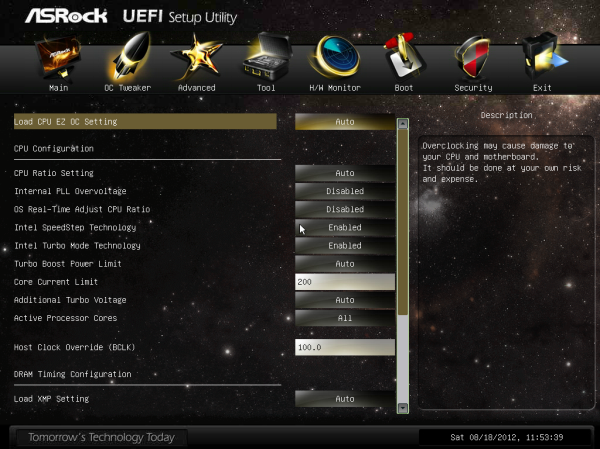
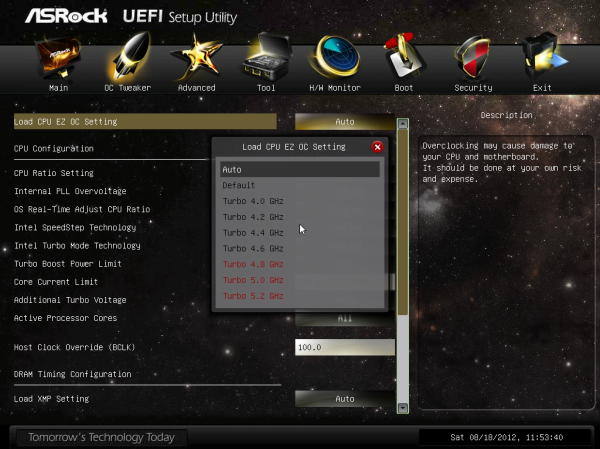
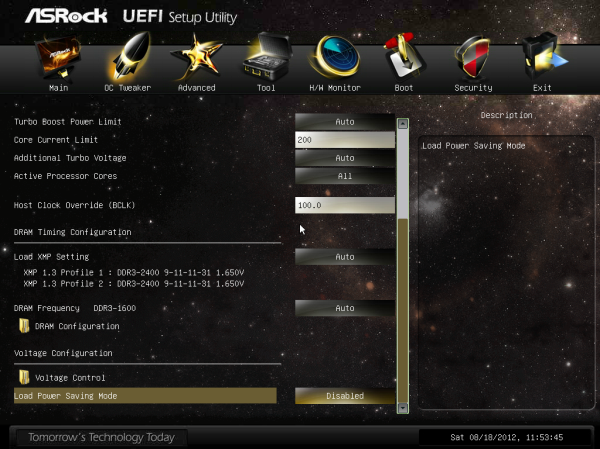
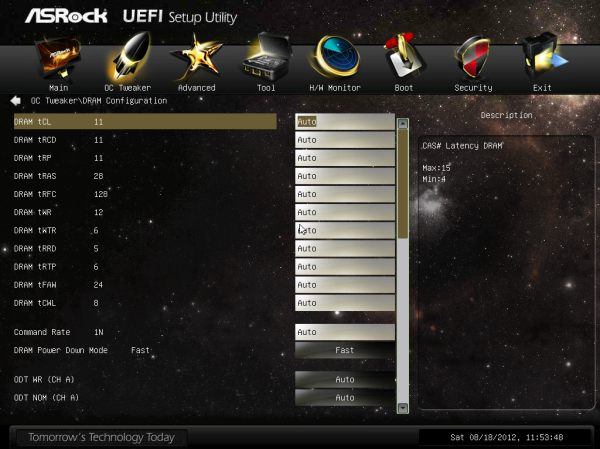
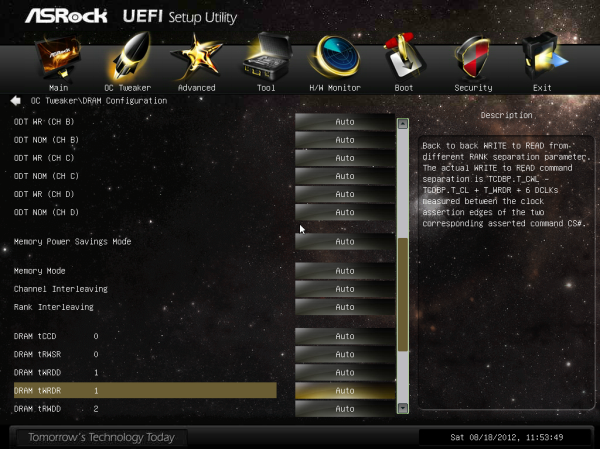
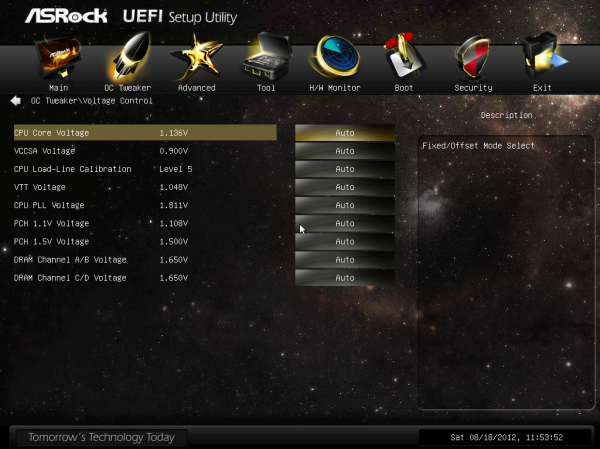

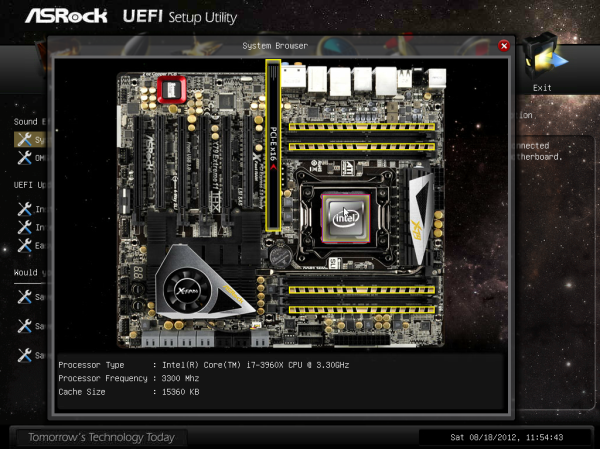
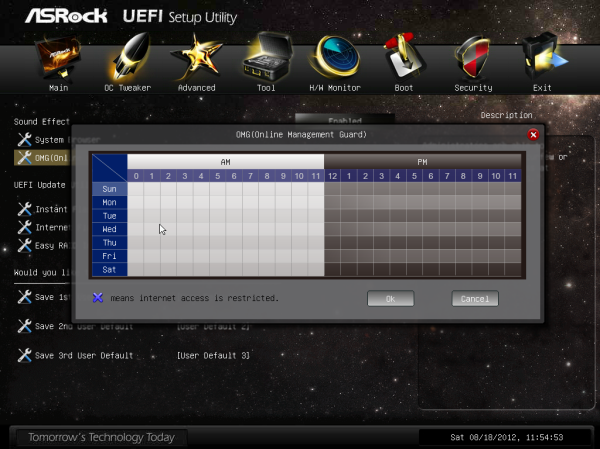















62 Comments
View All Comments
Azethoth - Monday, September 3, 2012 - link
"a SAS". "an" is for words starting with vowels like "an error", "a" is for words starting with consonants like "a Serial Attached SCSI" or "a Storage Area Network" or "a SAS"*. It rolls off the tongue better when you don't have adjacent vowels.*Your particular English implementation may have different rules, these were the ones I grew up with. I find them simple and easy to apply.
lukarak - Tuesday, September 4, 2012 - link
That's not entirely true.It would be an 'a' if you read it as 'a sas'. But with SAS, we usually pronounce it as S A S, and then it goes with 'an'.
ahar - Tuesday, September 4, 2012 - link
Who's "we"? It doesn't include me. Why use three syllables when one will do?Do you also talk about R A M, or R A I D arrays, or an L A N?
Death666Angel - Tuesday, September 4, 2012 - link
Like lukarak said, that is not true. The English language uses "an", when the word following it starts with a vowel sound. That doesn't necessarily mean it has a vowel as the first character (see hour).As for abbreviations, there is no rule for it. Some people pronounce them like a single word, others don't. I use LAN, RAM, RAID as a word, but pronounce SAS as S.A.S. and SATA as S.ATA for example and SNES as S.NES. You can't appease both groups. So I think the writer of the article should go with whatever he feels most comfortable with, so that he avoids flipping between things unconsciously.
Death666Angel - Monday, September 3, 2012 - link
"If you believe the leaks/news online about an upcoming single slot GTX670, or want to purchase several single slot FirePro cards, then the ASRock will give you all that bandwidth as long as the user handles the heat."I'd probably slap some water coolers on there. Insane setup :D.
tynopik - Monday, September 3, 2012 - link
Is it even confirmed that this Ivy Bridge-E is coming out?shunya901 - Monday, September 3, 2012 - link
..............\.............\....http://www.frankfushi.com/
commonprosperity.org@hotmail.com
== ( http://commonprosperity.org )==
you can find many cheap and fashion stuff
jordan air max oakland raiders $30–39;
Ed Hardy AF JUICY POLO Bikini $20;
Handbags (Coach lv fendi d&g) $30
T shirts (Polo ,edhardy,lacoste) $15
Jean(True Religion,edhardy,coogi) $30
Sunglasses (Oakey,coach,gucci,Armaini) $15
New era cap $15
ypsylon - Tuesday, September 4, 2012 - link
But little is delivered.1. Primitive RAID option. Without even small cache it is as useful as Intel Storage Matrix RAID. Of course for R 1/10 parity calculations are not required so lack of XOR chip isn't an issue, but believe me even 128 MB of cache would improve performance greatly.
2. They bolted 8 SATA/SAS ports to the board instead using standard server oriented SFF-8087 connector. You get one cable running 4 drives not 4 separate cables for each separate drive. Very clumsy solution. And very, very cheap. Exactly what I expect of ASR.
3. If someone wants RAID buy a proper hardware controller, even for simple setups of R1/10 - plenty of choice on the market. When you change the board in the future you just unplug controller from old board and plug it into new one. No configuration is needed, all arrays remain the same. Idea of running RAID off the motherboard is truly hilarious, especially if somebody change boards every year or two.
4. Fan on south bridge (or the only bridge as north bridge is in the CPU now? ;) ). Have mercy!
5. They pretend it is WS oriented board yet they equip it with lame Broadcom NICs. Completely clueless, that kind of inept reasoning is really typical of ASRock.
6.And finally why persist with ATX. At least E-ATX would be better choice. Spacing some elements wouldn't hurt. Especially with 7 full PCI-Ex slots. Impossible to replace RAM when top slot is occupied, and with really big VGAs it really is tight squeeze between CPU, RAM and VGA. Why not drop top slot to allow air to circulate. Without proper cooling in the case there will be a pocket of hot air which will never move.
To sum up. Bloody expensive, dumb implementation of certain things, and cheaply made. Like 99% of ASRock products. Cheap Chinese fake dressed like Rolls-Royce. In short:stay away.
dgingeri - Tuesday, September 4, 2012 - link
1. Many server manufacturers equip their small business servers with a low end chip like that because of cost. Small businesses, like those who would build their own workstation class machines, have to deal with a limited budget. This works for this market space.2. I don't see any sign of a SFF-8087 port or cable. I see only SATA ports. Honestly, I would have preferred a SFF-8087 port/cable, as my Dell H200 in my Poweredge T110 II uses. It would take up less real estate on the board and be more manageable. I know this from experience.
3. Yeah, the Dell H200 (or it's replacement H310) has plenty of ports (8) and runs <$200 yet any hardware raid controller with a cache would run $400 for 4 ports or about $600 for 8. (I have a 3ware 9750 in my main machine that ran me $600.) Depending on your target market, cost could matter. They get what they can with the budget they have.
4. I'd have to agree with you on the fan, but there's also the little matter of keeping clearance for the video cards top populate the slots. Take off the decorative plate and make the heatsink bigger, and they could probably do without the fan. Unfortunately, there are lots of stupid people out there who buy things on looks rather than capability.
5. Broadcom NICs are vastly superior to the Realtek or Atheros NICs we usually see on DIY boards. I would be happier to see Intel NICs, but Broadcom is still the second best on the market. I have 2 dual port Broadcom NICs in my Dell T110 II machine (which I use as a VMWare ESXI box to train up for certification and my home server.)They work quite well, as long as you don't use link aggregation.
6. Many people wouldn't be able to afford a case that would handle E-ATX, especially the target market for this board.
For the target market, DIY part time IT guy for a small business trying to make a decent CAD station or graphics workstation, it would work fairly well. I'm just not sure about the reliability factor, which would cost a small business big time. I'd say stay away just on that factor. Do with a little less speed and more reliability if you want to stay in business. Dell makes some nice IB workstations that would be perfectly reliable, but wouldn't be as speedy as a SB-E machine.
08solsticegxp - Sunday, June 9, 2013 - link
You have to realize, this board is not a server board. If it was designed for that, I'm sure they would have two sockets. Also, it is much cheaper to add the LSI chip to the board than have it as an add-on card. If it was an add-on card... where do you expect it to go when using 4 Video cards?I think the board is designed very well for what it was intended for. You may want to consider looking at design as it relates to the intended purpose... Not, some other purpose.
I will agree to say I would have liked to see a Raid 5 option on the RAID controller. However, looking at the price of an LSI (who are noted for being a high quality RAID controller) it is pretty pricey when you start getting to the controllers that have RAID 5 as an option.